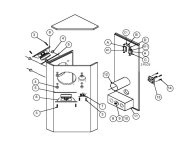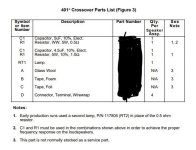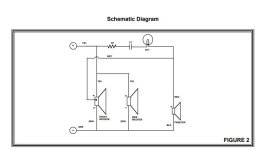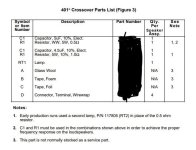I guess I am left with having to gently remove the two drivers and the tweeter, remove the poly-fill, and search for the caps that way. 🙁👎
Yes, you have no other option.
Are the connections to the woofer terminals wire wrapped?
If so, and you require to disconnect the woofers for ease of access, please note my remarks in post #15.
Oh, and take careful note of which colour of wire goes where!
Are the connections to the woofer terminals wire wrapped?
If so, and you require to disconnect the woofers for ease of access, please note my remarks in post #15.
Oh, and take careful note of which colour of wire goes where!
That's handy!
As I hinted at earlier (post #7), there may be two protection lamps as explained in the centre image.
As I hinted at earlier (post #7), there may be two protection lamps as explained in the centre image.
I have searched for the Bose 401 Service Manual, and have only found the Owner's manual which, for this task, is useless.
Yes, I believe the woofer connections are wire-wrapped. I will take your advice from #15 as well as the wire colors and their path! Since I am going this in-depth, would it make sense to replace all of the wire with one of a heavier gauge?Yes, you have no other option.
Are the connections to the woofer terminals wire wrapped?
If so, and you require to disconnect the woofers for ease of access, please note my remarks in post #15.
Oh, and take careful note of which colour of wire goes where!
Will you provide the legend for the exploded speaker diagram?
legend
The parts you are interested in are clearly labelled, i.e., C1, RT1 and R1.
Where C1 is a capacitor, RT1 is a lamp and R1 is a resistor (but may be a second lamp).
BTW, my 401's are from 1987. I would guess that Bose intends/intended for their speakers to have a long lifespan, so I wish they had included in their design a way to easily access and change the caps which do fail!
would it make sense to replace all of the wire with one of a heavier gauge?
Heavier gauge is really only a requirement for a long run of wire such as the cable from amplifier to speakers.
The resistance offered by the short lengths of the current internal wiring is negligible.
Replacing the wiring risks making mistakes, especially if you are a novice.
If you do choose to go ahead, 18 gauge is thick enough for internal wiring.
A heavier gauge can make soldering difficult and its weight may put undue stress on the driver terminals.
Last edited:
For a technician, this is a no-brainer, but I understand it's not that straightforward for a DIY-er.BTW, my 401's are from 1987. I would guess that Bose intends/intended for their speakers to have a long lifespan, so I wish they had included in their design a way to easily access and change the caps which do fail!
Good luck, I'm sure you'll succeed.
Hugo
Right, wire sizing is all about voltage drop over distance, so even high power rated speakers need surprisingly small internal wiring with the proverbial lamp cord being way overkill in most speakers, (sub) woofers.
I have re-wired many electrical components and also rebuilt and refurbished vintage radios (hobby only). I build my computers, too, so I have no problem working with electronics. I just like acquiring as much knowledge and tips as possible from those who have more experience than me with particular items!For a technician, this is a no-brainer, but I understand it's not that straightforward for a DIY-er.
Good luck, I'm sure you'll succeed.
Hugo
Thanks!
Lamp here (mentions red dot in description): https://www.ebay.com/itm/1337608652...lp:4247815&itmmeta=01HSK6BQZ9TT6V20MMR7V8QY3A
indianajo mentioned Parts Express where you will be able to source any other components.
However, let's wait and see what's actually inside your cabinets!
indianajo mentioned Parts Express where you will be able to source any other components.
However, let's wait and see what's actually inside your cabinets!
I find this part of the circuit interesting.
Yeah, I was going to ask about that!
What it does do is to furnish a good reason not to replace the existing wiring!
I find this part of the circuit interesting.
Could it be there to add inductance in parallel with the tweeter to form a second order HF crossover?
- Home
- Loudspeakers
- Multi-Way
- Information request for modifying Bose 401s




